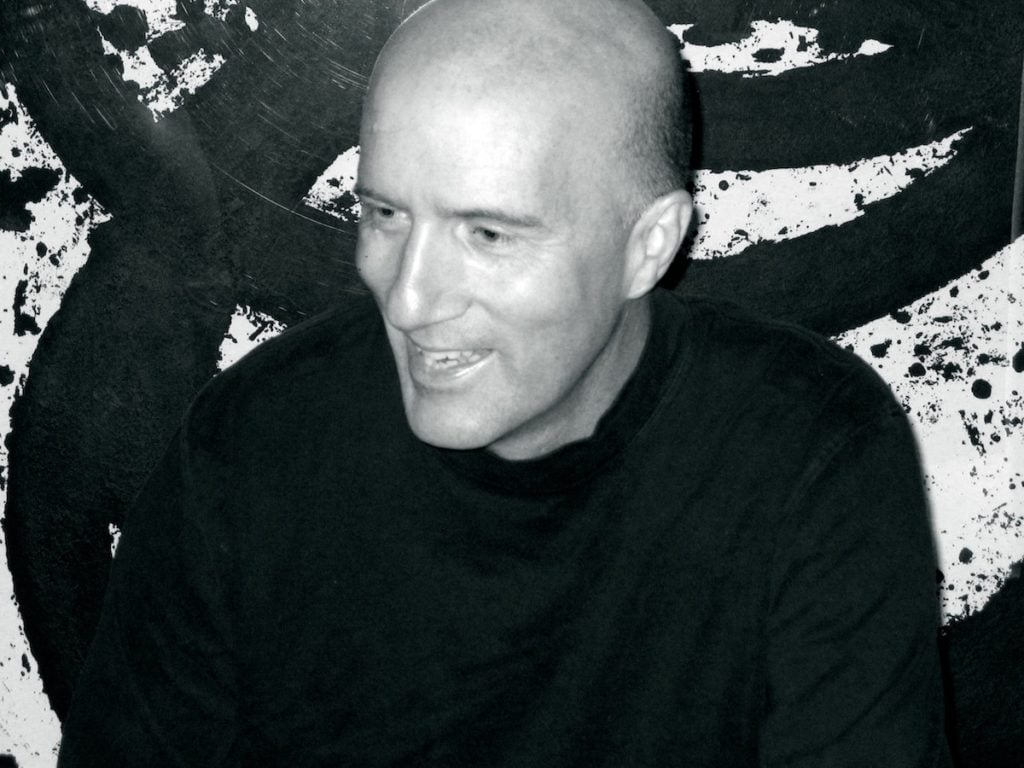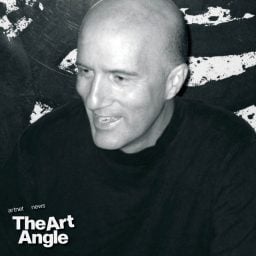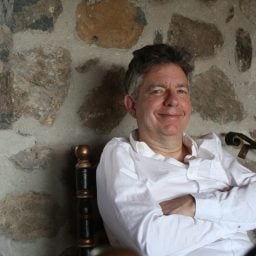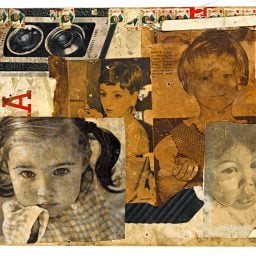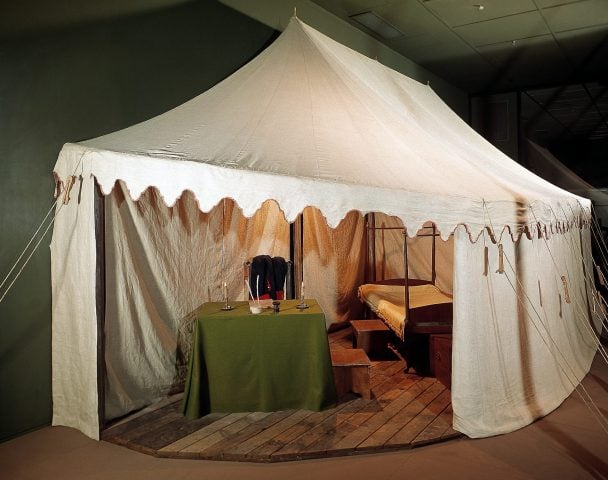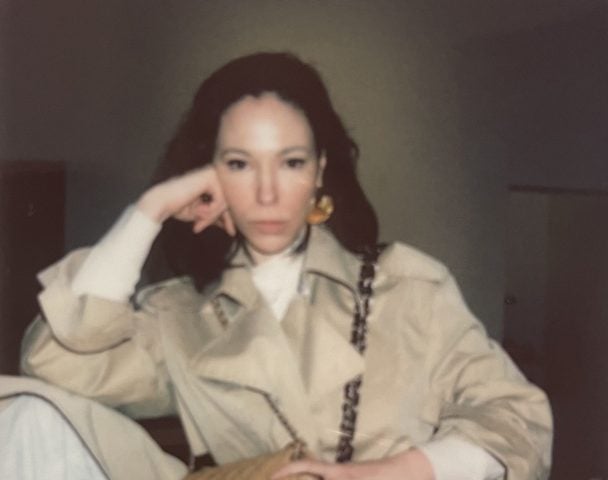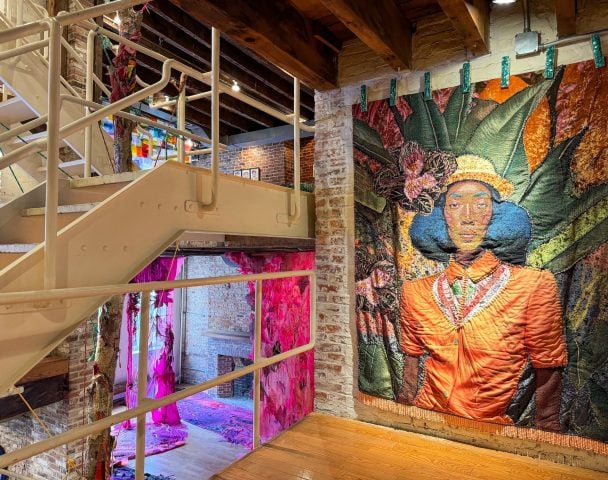There is a small historical irony in the topic of Hal Foster’s lecture for the 67th A.W. Mellon Lectures at the National Gallery of Art, set for next month: “Positive Barbarism: Brutal Aesthetics in the Postwar Period.”
Patrons Paul and Mary Mellon helped launch the lecture series in 1949, in the postwar moment when the United States was consolidating itself as an intellectual center. Their Bollingen Foundation, which was named after Carl Jung’s country home and which sponsored the Mellon Lectures, was committed to promoting the “steady drive toward reclaiming interiority, a quest for meaning… a part of the struggle for revaluation and rebounding of a collapsed Western civilization,” according to the NGA’s official history.
As it so happens, this postwar rhetoric of civilizational crisis is exactly what Foster, the eminent Princeton art historian and critic, returns to examine in his new project. In it, he looks to an eccentric constellations of artistic figures, among them Jean Dubuffet, the French father of Art Brut; the protean Danish artist Asger Jorn, who went from the CoBrA group to Situationism; the Scottish proto-Pop artist Eduardo Paolozzi; and the US-based Claes Oldenburg, best known for his deliriously gigantic sculptures of consumer objects. Foster looks to their work to try to understand the deep, unresolved spiritual and material crisis of postwar humanism, the implications of which stretch into the present.
Foster’s own influence is not in doubt. His writing has spanned the high theory journal October—where he has served as longtime editor—and the more general interest London Review of Books. He’s edited volumes that defined the theoretical landscape for several generations of scholars, such as The Anti-Aesthetic (1983), and set the tone for the art history curriculum via his role assembling (with fellow October editors Benjamin Buchloh, Rosalind Krauss, and Yves-Alain Bois) the textbook Art Since 1900 (2004). Volumes of his own essays range from the seminal Recodings: Art, Spectacle, Cultural Politics (1985) to his reflections on recent art in Bad New Days: Art, Criticism, Emergency (2015).
In the lead-up to Foster’s Mellon Lectures at the NGA, I spoke to him about the larger intellectual project they are part of, why our current political turmoil leads him to rethink the values of the European avant-grade, and the inspiration he takes from Marxist philosopher Walter Benjamin as well as from Carl Schmitt, the right-wing legal theorist of the Third Reich.
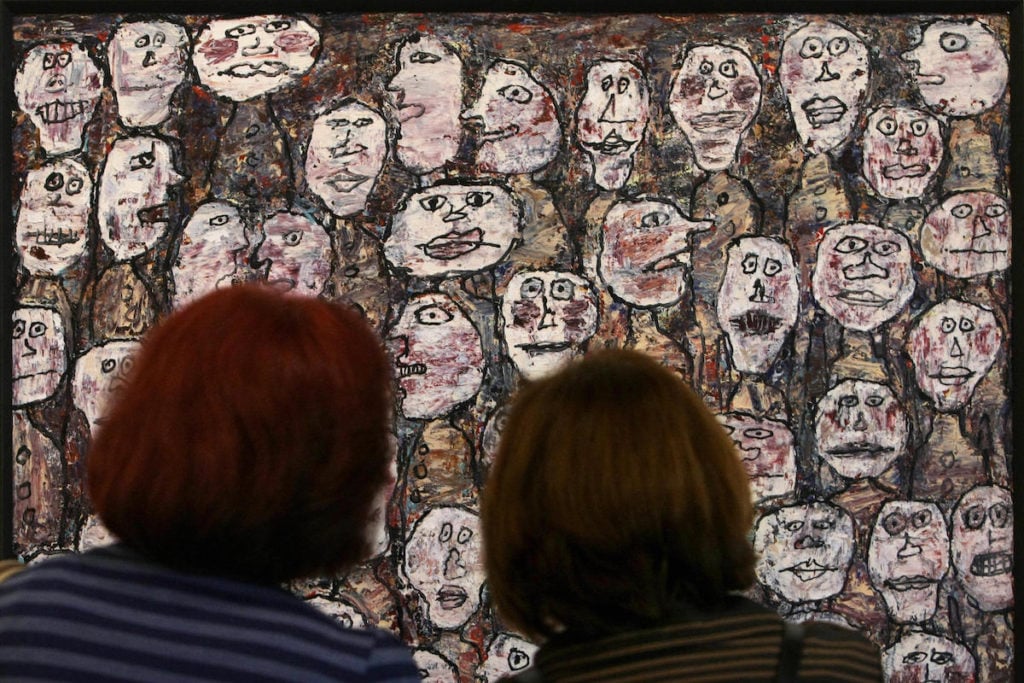
Visitors look at thr painting Affluence (1961) during the retrospective of Jean Dubuffet (1901-1985) in Sao Paulo, Brazil, on July 16, 2009. Image courtesy Mauricio Lima/AFP/Getty Images.
In your lecture, you’re addressing a particular constellation of figures. How did you conceptualize bringing them together?
It goes back to this riddle that I get from Walter Benjamin, that “modernism teaches us how to survive civilization.” He also has this extraordinary idea of a “positive barbarism,” which is similarly enigmatic. He never really explains what he means, but he locates the idea in the aftermath of World War I, when he said that artists and architects and writers had to “start from scratch, to make a new start, make a little go a long way.”
For me, that aperçu really bears more on the period after World War II than the period after World War I. After the First World War there are lots of different configurations, but among them is a reconstructive one, a return to order. That’s not possible after World War II. So I want to suggest that Benjamin anticipated a condition that follows him a decade or two on.
That was the real start of the idea: What would Benjamin’s “positive barbarism” mean after World War II? That got me on to questions of the brut and the brutalist, the animal and the creaturely. You see these tropes everywhere in the production of the 1950s, and that got me on to the artists and writers I take up in this project like Dubuffet, Bataille, Jorn, Paolozzi, and Oldenburg.
That’s really the germ of the project. In one way or another, all these figures propose a brutal aesthetic. They all want to, and need to, begin again.
You talk about thinking about them as an alternative avant-garde. You write, “My avant-garde is neither advanced nor rear… but caustically immanent,” and “it does not pretend that it can break absolutely with the old order or found a new one; rather, it seeks to trace fractures that already exist within the given order, to pressure them further, even to activate them somehow.” What is gained by imagining this alternative? What are you trying to avoid or steer away from?
That has been a concern in my work over a long period of time. In a way, these lectures are part of a larger, three-part project. One part deals with the avant-garde right around World War I and after. Bad New Days, about more recent art, is the third part, chronologically.
The basic idea is this: Our common sense of the avant-garde is that it is either transgressive or legislative. In other words, it sees an order that it wants to violate, or it sees the collapse of an order and proposes a new one. These are historically specific conditions, but I think they guide our sense the historical avant-garde.
For a long time now, this common sense has seemed to me to be inadequate, in a particular aspect: for so much of the 20th century—but particularly in the time of the historical avant-garde—most of Europe was in a state of emergency. Laws were actually suspended, here, there, and everywhere. So I wanted to rethink what the avant-garde was in that space of political, social, and epistemological uncertainty, in which there’s no order to violate or resist, and no order to found again—the condition Hugo Ball names in his diaries of Zürich Dada when he asks the question, “Where no laws seem to exist, what do artists or writers do then?”
That’s one thrust of the overall project, and as I say these lectures are just one part of that project. I think it proposes a view of the avant-garde that’s not so romantic, not so all-or-nothing. And it suggests that the symbolic order is not as solid as we make it out to be. There’s a way that the avant-garde projected an order and solidified it. But an order, it seems to me, is always fractured. This has become a commonplace in political theory, and I wanted to test this idea out in terms of the history of the artistic avant-garde.
I’m interested in critical practices that work much more immanently, that believe that there’s another side to the order in which they exist or that work within an order in order to pressure it, to turn cracks into new spaces.
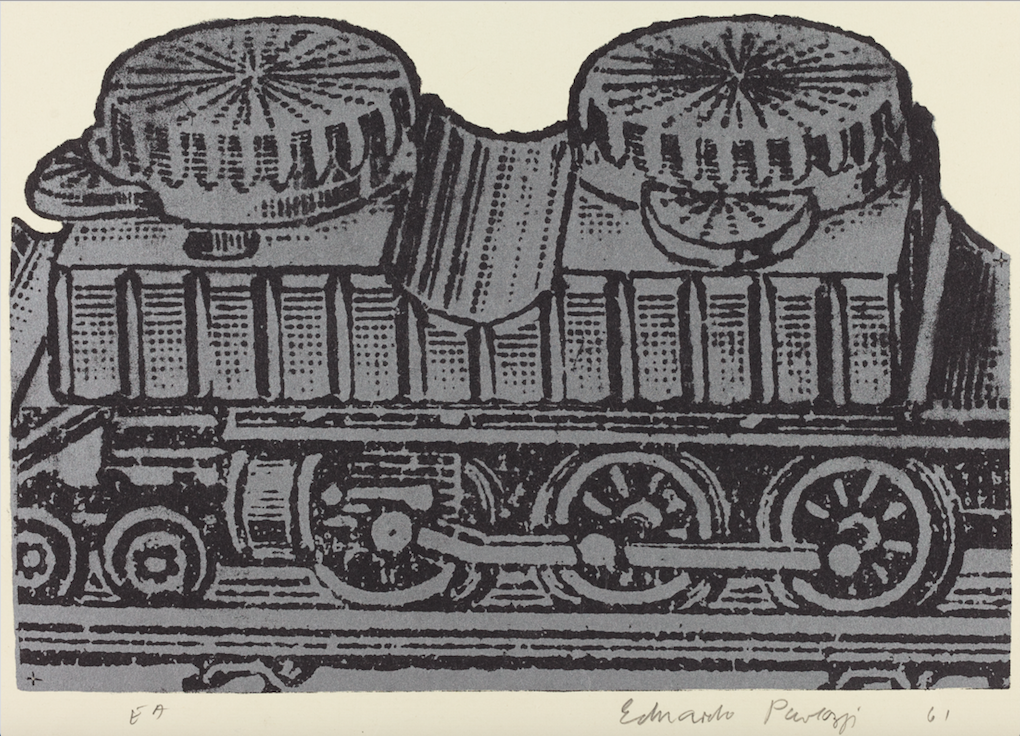
Eduardo Paolozzi, Inkwells (1961). National Gallery of Art, Washington, Gift of Mrs. Robert A. Hauslohner, Image courtesy National Gallery of Art.
In your description of this project, you mention the Surrealists and the Constructivists as providing the typical picture of avant-garde practice, representing the “transgressive” and the “legislative,” respectively. Your project is reacting against this rhetoric. Is this basically because you think that the rhetoric of complete ruptures or breaks represents a kind of absolutism that you see shading over into forms of absolutist political thinking? Is that what you are reacting against?
Totally. I grew up on the “end of” discourse: there was always an end of this or that. Everything was a break, everything was a rupture. In many ways I think that was a continuation in theory of a political desire for transformation. Personally, I suppose I drank the apocalyptic Kool-Aid.
And I’m not now sure that was historically accurate. I’m not sure that the “end of” discourse serves us in the present. This project, like most of my projects, begins out of a sense of present conditions. What I like to do—and this is where the work of the critic is one with the work of the historian and the theorist—is to be driven by contemporary concerns that open up a historical project, a new way to think about the past which can then connect us to practices in the present.
I was reading your famous critique of modernist primitivism, “The ‘Primitive Unconscious’ of Modern Art” [from Recodings]. There you make this distinction between primitivism as the appropriation of the other in a mythic way that freezes its image, and the idea of bricolage, which you say offers a positive model of “intercultural exchange.” Do you find that distinction still useful? Does it fit into what you’re doing here?
I think there are connections. I think it’s also important not to see these artists as belated or “neo-Primitivists.” Certainly Dubuffet was very interested in “the child, the other, and the insane”—the great Modernist trio—but it’s pitched differently.
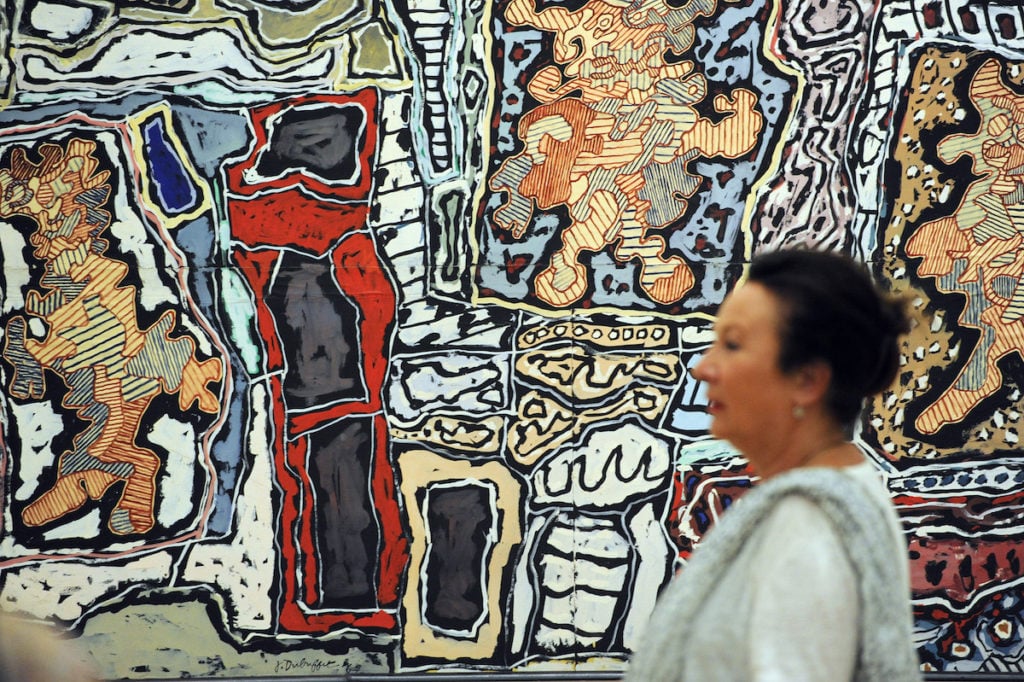
A visitor passes by Continuum de ville by Jean Dubuffet at the Granet museum in Aix-en-Provence, southern France. Photo courtesy Gerard Julien/AFP/Getty Images.
I suppose your whole project is a little bit about that difference.
There is a way in which Dubuffet still wants to see an outside to culture. That’s really what Art Brut is for him. So there is a strong Primitivist dimension there. But he was also interested in the “common man,” as he calls it, which he imagined as a kind of destitute outlaw. My other figures have a similar interest.
My argument is that more than primitive life, it is “bare life”—in Giorgio Agamben’s sense—that is at stake for many of these figures. It’s a matter of power and its objects instead of culture and its others. For me there is an important difference there.
There’s a whole list of avatars that are related to the Modernist ones but different. If the animal was important to some Modernists, the creature or the creaturely is the figure that interests me; if the engineer was the model of the artist for many Modernists, here it’s the bricoleur. So you’re right, bricolage is an important idea for me in this project. It’s now a very common idea, but I want to return it to the moment of its articulation.
[Claude] Lévi-Strauss comes up with this idea of bricolage during the period that interests me. He’s actually in conversation with Dubuffet; Art Brut is one of the first instances of bricolage. And Lévi-Strauss actually makes the distinction between the engineer and the bricoleur that I want to take up. This is important to me artistically and formally in a couple of different ways in this project, since all my artists take up the already given.
Figures like Paolozzi talk about the “as found.” So they start from scratch, but they start from leftovers. The idea of bricolage, or what is given, allows me to move them away from very basic, very reified stories about the readymade and collage. And then in terms of bricolage too there’s a reconstructive impulse in the work that interests me.
For example, one of the great mottos of Oldenburg is “annihilate, illuminate.” It’s always both/and. There’s still this very strong destructive imperative among these artists that interest me, but there’s also a reconstructive one. They want to begin again.
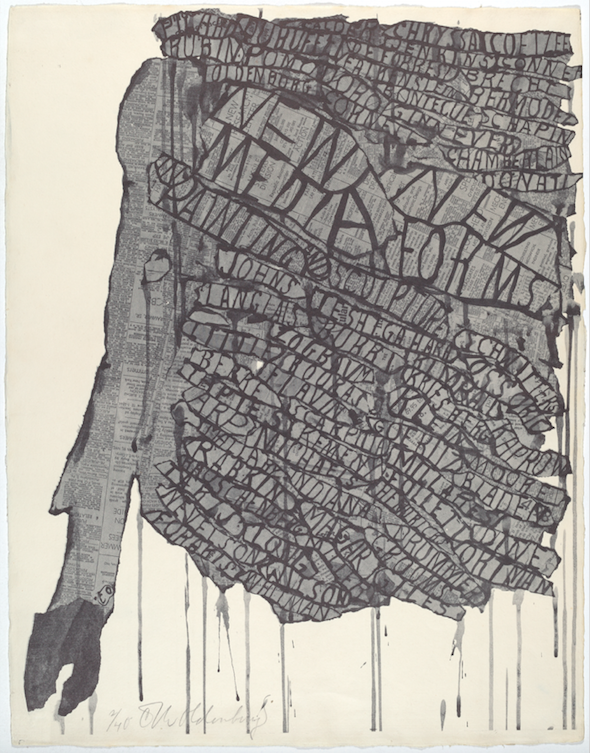
Claes Oldenburg, New Media-New Forms in Painting and Sculpture (1960). Image courtesy National Gallery of Art.
This idea of pairs of terms is interesting. It reminds me of this psychoanalytic idea that there’s no emotion that’s bad or good, that what matters is how an emotion is integrated. So, we think of happiness as positive, but it’s bad if it’s merely contentment, keeping you in a bad situation. And sadness is bad if it becomes depression, but positive when it’s grief—when it’s a cathartic way to process something that has really affected you. Do you think that your pairs represent a formal difference, or is it more about how these tropes function or are integrated into a praxis?
When you get to Oldenburg, it becomes clear that this way of thinking through contraries is very, very important. And for all the figures that I take up, the sense of working through contraries is a real problem and it’s connected to both politics and to history. It’s a real problem of dialectics. It reflects a sense that history has run into the sand, and that politics has too.
Some really want to think dialectically, but they don’t feel that they can. Some actually force a reimagining of dialectal thought. I mean, Jorn comes up with a completely crazy idea of “triolectics.” I think that this is a sign or a symptom that they all feel stuck historically, that ideologies have crashed and burned. They have to begin again. And they’re just not quite sure how it can be done.
Some try for a revival of dialectics. Some are quite post-dialectical. And to me there is a strong proto-deconstructive dimension in some of these figures. But they are all bound up with a historical predicament in which they feel literally stuck. Debuffet uses this term again and again: “stuck.” That really interests me in relation to the present too.
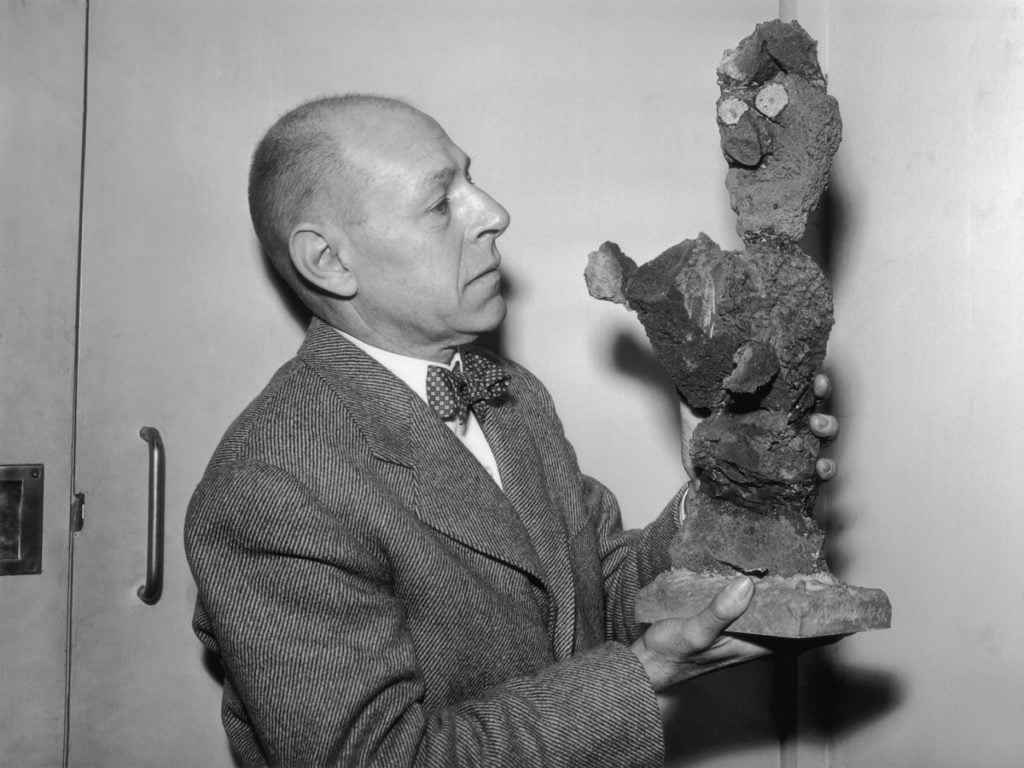
Jean Dubuffet with one of his volcanic lava sculptures entitled Madame j’ordonne (1954), March 29, 1955. Photo by Harry Todd/Fox Photos/Hulton Archive/Getty Images.
I went back and read “Experience and Poverty,” the fascinating text by Walter Benjamin from 1933 you are drawing on. He analyzes everything from glass architecture to Mickey Mouse and, in a way somewhat similar to his more famous essay on “The Work of Art in the Age of Mechanical Reproduction,” he has this idea that these phenomena represent the creation of a new mass sensibility, which he projects toward some sort of new popular, possibly socialist subject. Are you connecting “brutal aesthetics” to that theme, or is that hope neutralized or compromised by the post-World War II period that you’re talking about?
The sense you get in Benjamin’s “Work of Art” essay that there’s a way to ride technological transformation into a new order—I think that was desperate even as he uttered it.
In “Experience and Poverty,” he has a wildly dialectical view of technology. On the one hand, it has devastated the human. After World War I, there’s the sense of the human subject having been torn apart on the landscape of battle.
On the other hand, Benjamin still believes, through the figure of Mickey Mouse, that technology can be troped: that the human could be remade technologically, and technology remade humanly. And that is just not a prospect after World War II. That’s another real change that I see.
Here’s another, political difference: Again somewhat desperately, Benjamin proposed this idea of a “positive barbarism” in lieu of a moribund bourgeois culture. This is a familiar move on his part. But he wants to see in Modernism a configuration of a socialist order to come. That’s very strong in the Modernist episteme. T.J. Clark also links the two.
I’m not so convinced that the link was ever so secure, and after World War II it’s certainly broken. That’s not to say that these figures I take up are not on the left. I mean, Dubuffet is a problematic character, and Bataille to an extent too, but the others certainly are on the left. The problem is that what can stand as a proletarian culture or a socialist culture is not at all clear.
When Benjamin talks about barbarism, he uses an unusual word in German. Usually the opposite of civilization is “Barbarei.” The term he uses is “Barbarentum,” which might be translated as “barbarianhood.” So in the term “positive barbarism” he imagines a collective. And there is a way in which my figures do too, but without the proletariat as any subject of history on the horizon. It’s even more desperate.
Dubuffet is actually quite close to the idea of the lumpenproletariat in Marx. This is his idea of the “common man” again, very much as Marx defined the lumpenproletariat as the “refuse of all classes.” That is why Dubuffet is politically so problematic, because the lumpenproletariat in Marx is subject to reaction as much as anything else.
Jorn also imagines “barbarianhood,” in his own way. He’s committed to collaboration. He did murals and ceramics and publications with all kinds of different people, and he sees them as figures of a communal life to come.
Paolozzi in its own way searches for archetypes in mass culture and wants to find a way to trope that collectivity in a different way, to seize back an idea of the archetypal or the iconic, as he calls it, for art. And actually Oldenburg does the same thing.
So even though they feel politically stuck and historically static they still want to image a culture, and maybe a collectivity. It’s just that the conditions make it difficult to do so.
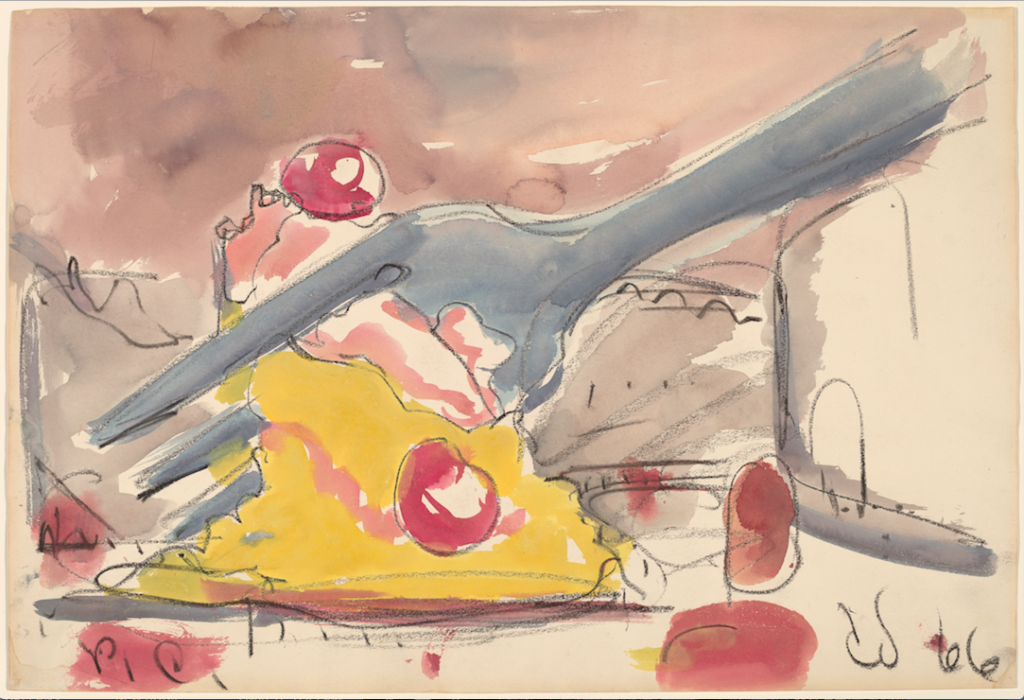
Claes Oldenburg, Fork Cutting Cake No. 1: Proposed Colossal Monument for Piccadilly Circus, London (1966). National Gallery of Art, Washington, Director’s Discretionary Fund. Image courtesy National Gallery of Art.
I want to ask about the postwar period, because recently there’s been a real rethinking of what “postwar” means. There was this show at the Haus der Kunst last year, “Postwar: Art Between the Pacific and the Atlantic,” that tried to look at that period in a more global, expanded way, challenging the idea that the only interesting things in that time period happened in Europe and America. How do you think your examination of the Euro-American postwar fits with that bigger project?
There is this interest recently in the postwar 1950s, and the Haus der Kunst project actually goes into the early 1960s. In large part, this is because the two dominant models for my generation of critical historians were avant-garde/neo-avant-garde and Modernism/postmodernism. As a consequence, historians were somewhat blindspotted in terms of the 1950s. The neo-avant-garde framework really focused on the return of avant-garde devices in the late ’50s and through the ’60s and into the ’70s, and the postmodern framework really focused on the ’70s, the ’80s, and into the ’90s.
So there’s a way in which the actual period of the break in the century was left out of the analysis for a long time. In part too that was because it was so inflated in studies of Modernist painting. That absence is one reason why critics and scholars and curators have returned to this period.
At the same time, I should say that the demand to look at that art history in a global frame has everything to do with that imperative in the present. People like Okwui [Enwezor] have wanted to run that global imperative within the historical field. And I think that’s extremely important to do—and important to do in the prewar period as well, though that’s a little bit more difficult because there it’s really an international scene, not a global one. Vis-à-vis this global frame of postwar studies, my project could be seen as somewhat retrograde.
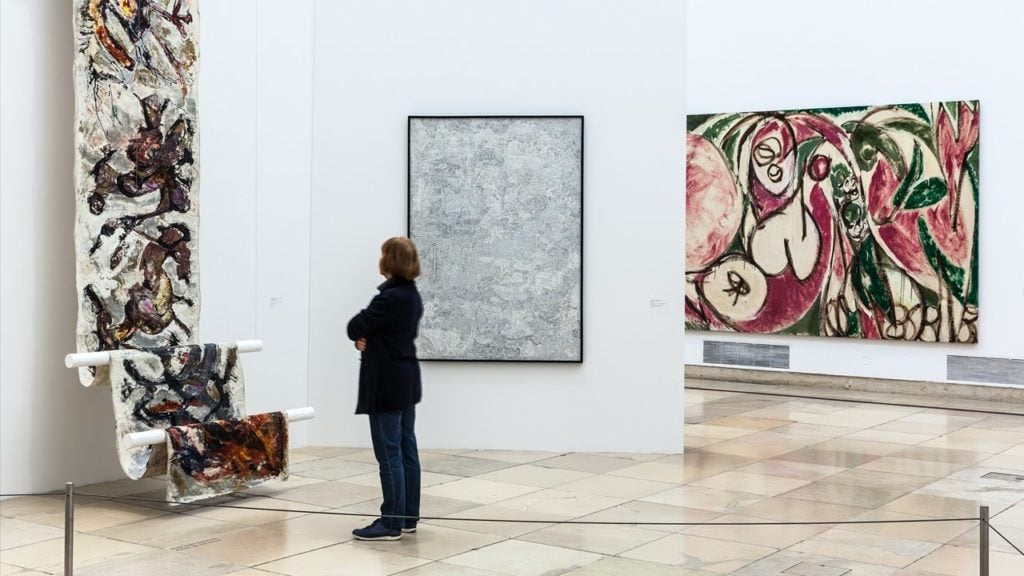
Installation view of “Postwar: Art Between the Pacific and the Atlantic, 1945–1965” at the Haus der Kunst. Image courtesy Haus der Kunst.
I can imagine you getting criticized for it. Like, we’re back to white guy history again.
Absolutely. And what I have is more of an apology than a defense. I do think that my figures were not as alert as they should have been to the barbarisms of colonialism and sexism. Certainly, Jorn was interested in the Algerian conflict, and Oldenberg in Vietnam, just to give two examples. But they don’t show great solidarity. And the misogyny of some of the works or texts that I take up is really difficult for a contemporary audience.
This period was preoccupied with what Mark Greif calls the “crisis of man” discourse. They were obsessed with the disaster of humanism and how to put it back together, so there’s a real emphasis on the human as such. Which also makes them insensitive to difference and diversity.
But there is a real methodological dilemma here, which is also a political conundrum: how do we deal with the problematic aspects of our objects of study? How not either to judge them according to anachronistic standards, or simply to excuse them by historical relativism: “Everybody was a jerk then, so why accuse them of jerk-dom”?
Again, I don’t have a defense. I am intrigued by these figures. I’m intrigued in part because they are complicated and problematic. Some are quite well known, but I look at aspects that are not so familiar. My Bataille is not the Bataille of Surrealism; he’s the Bataille of cave paintings. My Jorn is not the Jorn of the Situationists; he’s the Jorn of CoBrA. So my project is not simply canonical.
I will anticipate my critics and say that these are problematic guys, and that’s in part what interests me about them.
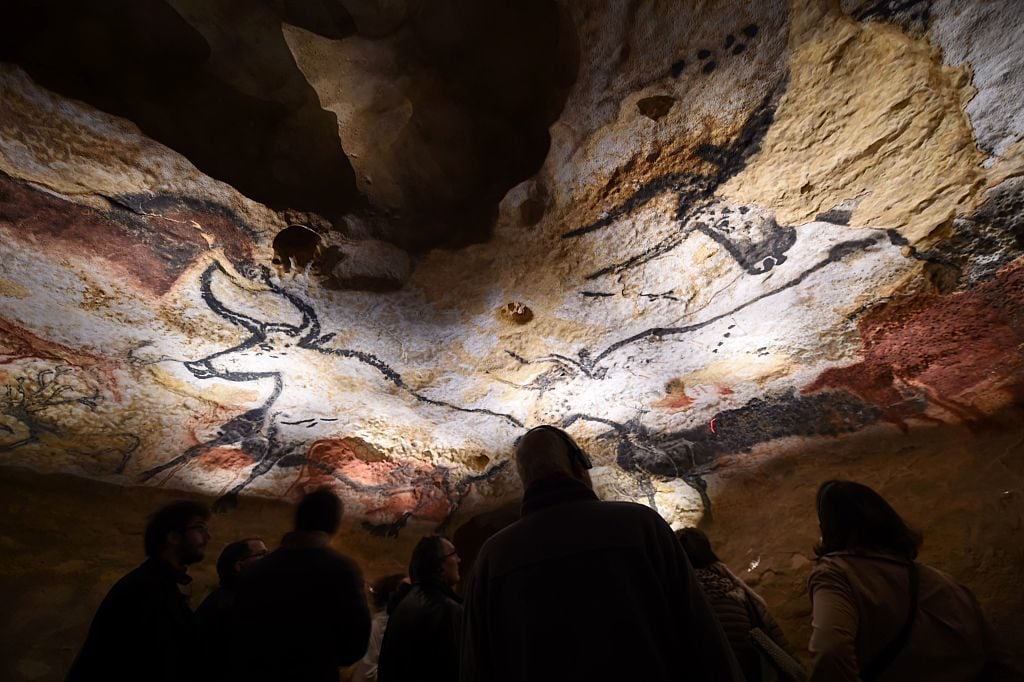
People visit the new replica of the Lascaux cave paintings, during the first public opening on December 15, 2016 in Montignac. Lascaux was a subject of fascination for Georges Bataille. Photo courtesy Mehdi Fedouach/AFP/Getty Images.
In terms of projecting anachronistic standards backwards, and the connections that you do draw, I was reading Bad New Days, where you use a similar language of a “caustically immanent” strain within art to look at the more recent period. You pull out a word cloud of terms that define post-’89 art in that book, and I guess I can see a connection to the material you are covering in these lectures via ideas like the “abject” and “precarity.” How are you making the leap?
That is the connection for me. Once again, for a long time now we have lived in an intermittent state of emergency. It wasn’t just Bush, it was also Obama, and Trump has just made it all the more flagrant. That’s the contemporary imperative that launched me on this project.
I suppose there is the implication in this project that we need to explore “positive barbarism” in the present. I am drawn to artists who can be seen to do so, artists like Isa Genzken and Thomas Hirschhorn.
Political theorists are fatigued by the intellectual turn to Carl Schmitt, which puts emphasis on exceptional politics, the politics of emergency. But I don’t think that we’ve really dealt with this Schmittian turn at the cultural level yet. It’s certainly opened up new ways for me to think.
And as it is for thinkers who have explored the state of emergency more directly in political theory, like Derrida or Agamben or even Chantal Mouffe, to me the project is to think with Schmidt against Schmidt. I mean, Schmidt is a figure of the right, obviously, and I think on the left too we need to think about the extremity of our condition, historically, politically, socio-economically, and to find an aesthetic that’s adequate to it—and not an aesthetic that is compensatory.
As much as I was interested in relational aesthetics, there was a way in which it was compensatory, as if you have lost society elsewhere but maybe you can find it in the enclaves of art. I wanted to go the other direction and see if there’s a way to think about a critical practice that takes up contemporary conditions directly, objectively, harshly—that is, barbarically—as Benjamin thought that Modernist artists, Modernist architects, Modernist writers had done.
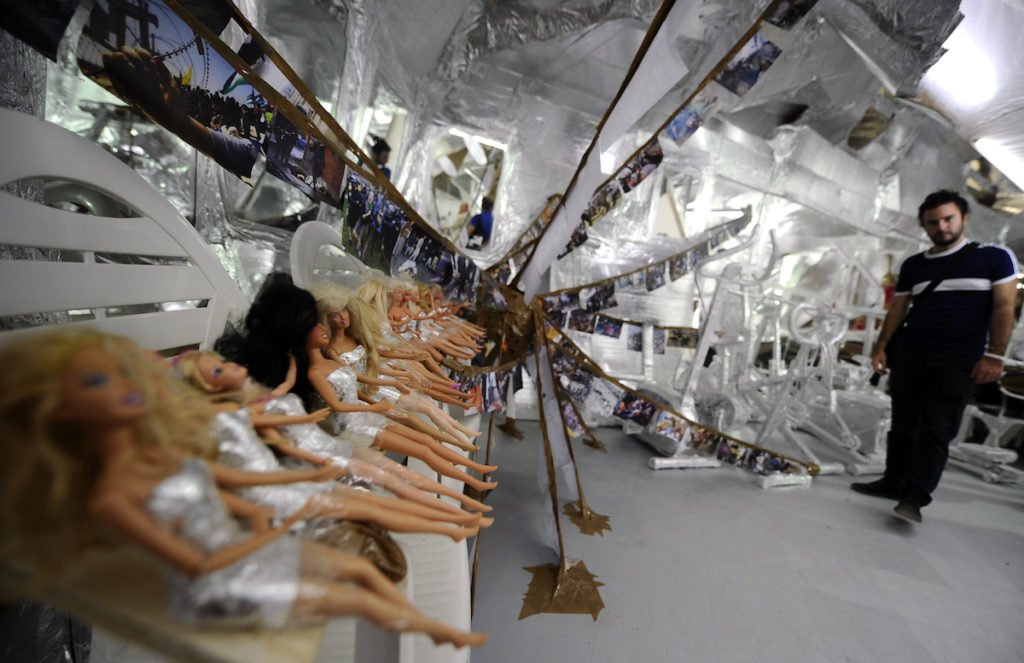
An installation by Thomas Hirschhorn at the 54th Venice Biennale, June 2, 2011. Photo courtesy Filippo Monteforte/AFP/Getty Images.
There is a danger with the “barbarian” terminology, right? It has a certain kind of coding. I remember even during Occupy Wall Street there immediately were criticisms where people would argue that “occupation” means different things for historically occupied peoples than it does for people in New York trying to claim their space.
Yes, but I think that this is one thing that people like you and me do: we fight over terms; we attempt to trope them, to transvalue them. I think that move, where one is caught up short because of a term, is not totally adequate—because, yes, of course “occupation” means one thing in New York and another thing in Gaza, but maybe they are connected. The whole point is to follow these mediations. That’s what good critics do.
I think Benjamin was quite aware that this troping of “barbarism” was a shock. He did it again in relation to his own Theses on the Philosophy of History, the most famous of which is that “every document of civilization is a document of barbarism.” So that reversal is already given.
In a way this is why my project is really articulated under the aegis of “brutal aesthetics.” I’m happy to give up the term if it is not effective or if it’s counterproductive. I do think that there’s a critical value in the transvaluation of terms. That’s part of what I’m doing with this project.
This aesthetic or anti-aesthetic is a dangerous one, as I pointed out in my work on Hugo Ball. I see it in a figure like Isa Genzken as well, where you take on the chaos of the time, maybe even take it in to the point, as Ball said, of self-disintegration. The exposure of barbarism has real dangers, real risks, not only as a cultural position but as a subjective disposition. It is very hard to sustain.
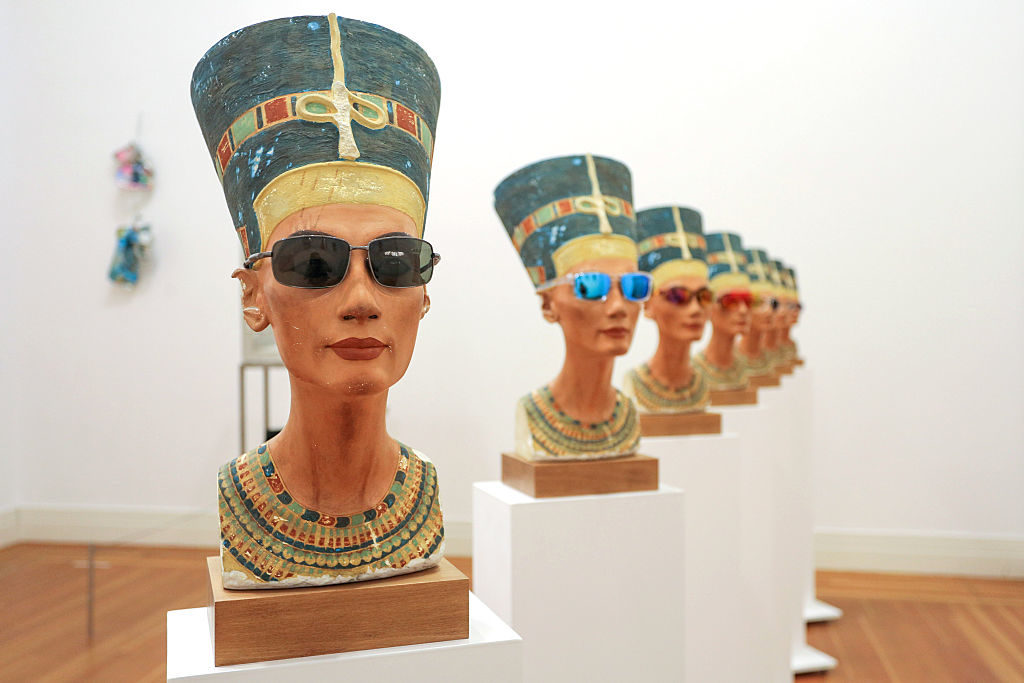
Nofretete by Isa Genzken in “Isa Genzken—Mach dich huebsch!—Make Yourself Pretty!” at Martin Gropius Bau on April 8, 2016. Photo courtesy Christian Marquardt/Getty Images.
You talk about “brutal aesthetics” as a reaction to the historical sense that “the humanist tradition had failed to prevent both World War and fascist reaction.” I guess I’ve been wondering if your attempts in this project to trace alternative art historical lineages doesn’t reflect a mirrored contemporary disenchantment. There was this critical moment of postmodernism, where it was associated with liberation. But that ultimately has coincided with the rising sense of emergency that you’ve been talking about: an extreme right-wing drift across the world. And some of the postmodern rhetoric about decentering narratives of truth and science has been adopted by global warming skeptics and white nationalists.
So how much of your attempt to trace critical lineages in the past is a part of that reckoning in the present?
That’s a keen point. In a way, I have understood this project personally. I was formed by the anti-humanisms of the 1960s, the critiques of representation, the critiques of origins. And I am drawn to this postwar moment and these figures because they actually precede such critiques. In part, I wanted to think about who the figures like Althusser and Lacan and Foucault and Derrida and Delueze were reacting against.
Because my figures are actually interested in beginning again. They are interested in valid representations. And for all the sense of the catastrophe of humanism, they work very much in the name of the human—it’s just a human that is very denatured. They want to think about what the human is, or was, then; they don’t want to give up on humanism. They just want to make a humanism that’s adequate to relate to the destruction of the human.
And this is an impossible project. That’s what interests me about these figures, that they come up with impossible ideas and limit concepts like “the brut.” How can there be an art outside of art, or a culture outside of culture? Or with Bataille there’s this idea that somehow the sacred can be found again in the caves. These are impossible projects.
I think they speak to what Jorn calls a sense of humanism as inhuman, and a corresponding search for a humanism that would not be inhuman. That seems to me important for our present as well.
Follow Artnet News on Facebook:
Want to stay ahead of the art world? Subscribe to our newsletter to get the breaking news, eye-opening interviews, and incisive critical takes that drive the conversation forward.
